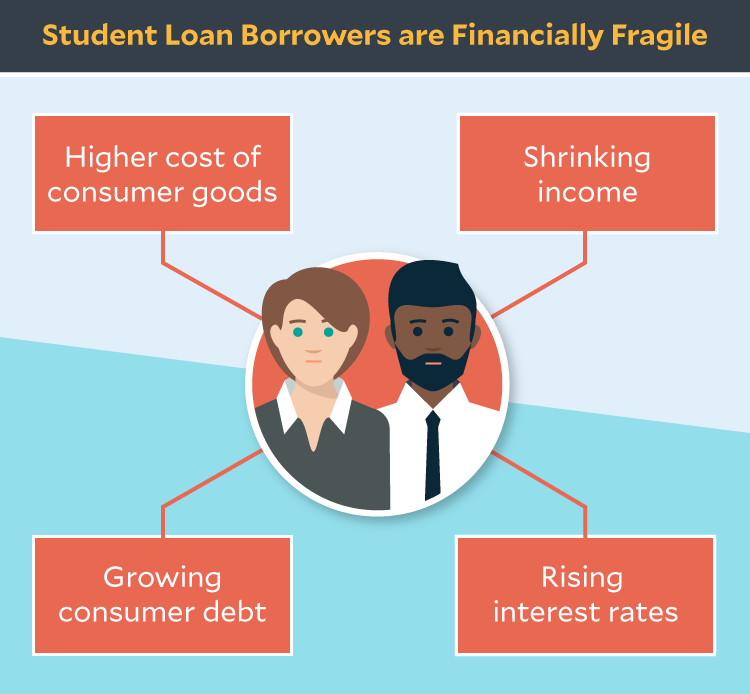





Posted 1/11/2024
Throughout 2023, Student Connections warned of a coming repayment crisis. A few months into repayment, we’re getting our first look at how bad the situation is. Spoiler alert – it’s worse than most predicted.
A December 2023 report from the Department of Education (ED) stated 22 million borrowers had payments due in October. Of those, 40% failed to make their payment by mid-November.
That staggering figure can be partially attributed to the continued financial fallout of the pandemic. Economic pressures have steadily increased over the past several years. Historically high inflation drove up the cost of consumer goods, reducing consumers’ individual buying power. College-educated workers also saw the value of their wages shrink despite many receiving raises. Consumer debt rose and skyrocketing interest rates have made that difficult to pay off.
By the time repayment began, millions of borrowers were financially fragile. They simply had no room in their budget for one more large debt payment.

The good news is there are options for student loan borrowers in crisis. For low- to mid-income borrowers, ED’s new SAVE Repayment Plan may be ideal. It provides a path to stay current on loan payments while keeping their budgets intact. Unfortunately, they may need help to switch plans, and that’s the crux of the repayment crisis.
Each loan servicer has a federally-mandated customer support unit to provide guidance to confused and struggling borrowers. Before the payment pause, all units combined helped a steady trickle of 325,000 borrowers entering repayment each month.

Despite having years to prepare, the system was not expanded to meet the present need. In response to U.S. congressional inquiries, loan servicers have cited issues including:
It’s also worth noting that the same Congress questioning servicers today chose not to increase funding for support centers when warned about the problem earlier in 2023.
Regardless of the cause, the results have been predictably disastrous:
A borrower who can’t afford their monthly payment and can’t speak with their loan servicer has few choices. Given the conditions on the ground, it’s hardly surprising that so many failed to make a payment.
ED announced that all borrowers affected by servicing errors would be protected from any financial damage caused by the errors. They granted them a retroactive forbearance (that expired on Dec. 31, 2023) and have taken steps to address the problems that caused the errors.
To help address the flood of borrowers entering repayment, ED has created a 12-month on-ramp period. Borrowers are expected to make payments, and interest will continue to accrue on their loans. However, they won’t be reported as delinquent to the credit bureaus and cannot default on their loans through Sept. 30, 2024.
It’s a period of chaos and mass student-loan delinquency. It’s going to be a rocky road for the foreseeable future, but you can take steps to help your current and former students navigate their options.
Student Connections has decades of experience reaching out to student loan borrowers. We understand the impact proactive outreach and counseling can have. Based on our experience, there are four primary steps you should take to help your borrowers:
Leverage creative, multi-channel communication. Millions of borrowers missed the news that student loan payment has restarted. That’s despite outreach campaigns launched by FSA and student loan servicers. It demonstrates the difficulty of delivering a message in a world saturated by data.
Your school can help spread vital information to your former students. Schools are a trusted resource borrowers are less likely to tune out. Work with your communications team or a trusted outreach partner to keep them up to date on news related to loan repayment. We find it’s helpful to use a combination of phone calls, emails, text messages, and targeted social media posts to best reach your target audience.
Highlight self-service alternatives. Borrowers can answer many of their own questions without talking to their loan servicer. Information like payment monthly amount, remaining total debt, and payment due date are easily accessible online. It’s simply a matter of knowing where to look.
We created the borrower-facing website My.StudentConnections.com to answer borrowers’ most frequently asked questions. There, they can learn how to lower monthly payments and where to find info on their student loans. The more borrowers can help themselves, the less time they’ll need to spend on hold waiting for a borrower support rep.
Additional self-help tips for borrowers can be found in our borrower-facing news article on dealing with long hold times for student loan servicers.
Help borrowers get on the right repayment plan.
There are several options beyond the Standard Repayment Plan, but borrowers often are overwhelmed when they explore these options.Help simplify the process. Encourage your former students to start by reviewing the new Saving on a Valuable Education (SAVE) Plan. More than 50% of the 5.5 million borrowers enrolled in the SAVE Plan qualify for a $0 payment.
To explore and compare all available repayment plans, borrowers can use FSA’s Loan Simulator to determine which repayment plans they are eligible to use and view the estimated monthly payment under each option.
Provide borrowers transparency and empathy. Outreach programs are necessary for overall repayment success. There are emotional and mental barriers that block financially vulnerable borrowers from getting help. Stress, fear, and confusion must be addressed. We’ve personally seen the positive impact expert loan counseling can have on anxious and fearful students.
If you feel overwhelmed, don’t panic! Most schools don’t have the resources or expertise to provide a full-service counseling solution. Student Connections does.
We can amplify your school’s efforts by determining which of your borrowers are most at risk and reaching out to them on your behalf. We’re able to run any aspect of your campaign, and it will probably cost less than you imagine.
Student Connections uses a blend of text, email, and phone outreach to connect former students to our team of experienced, highly-trained Borrower Advocates. Throughout the payment pause, they helped over 700,000 borrowers prepare for successful repayment.
Whatever you need, we can help! Contact Student Connections today to learn more.